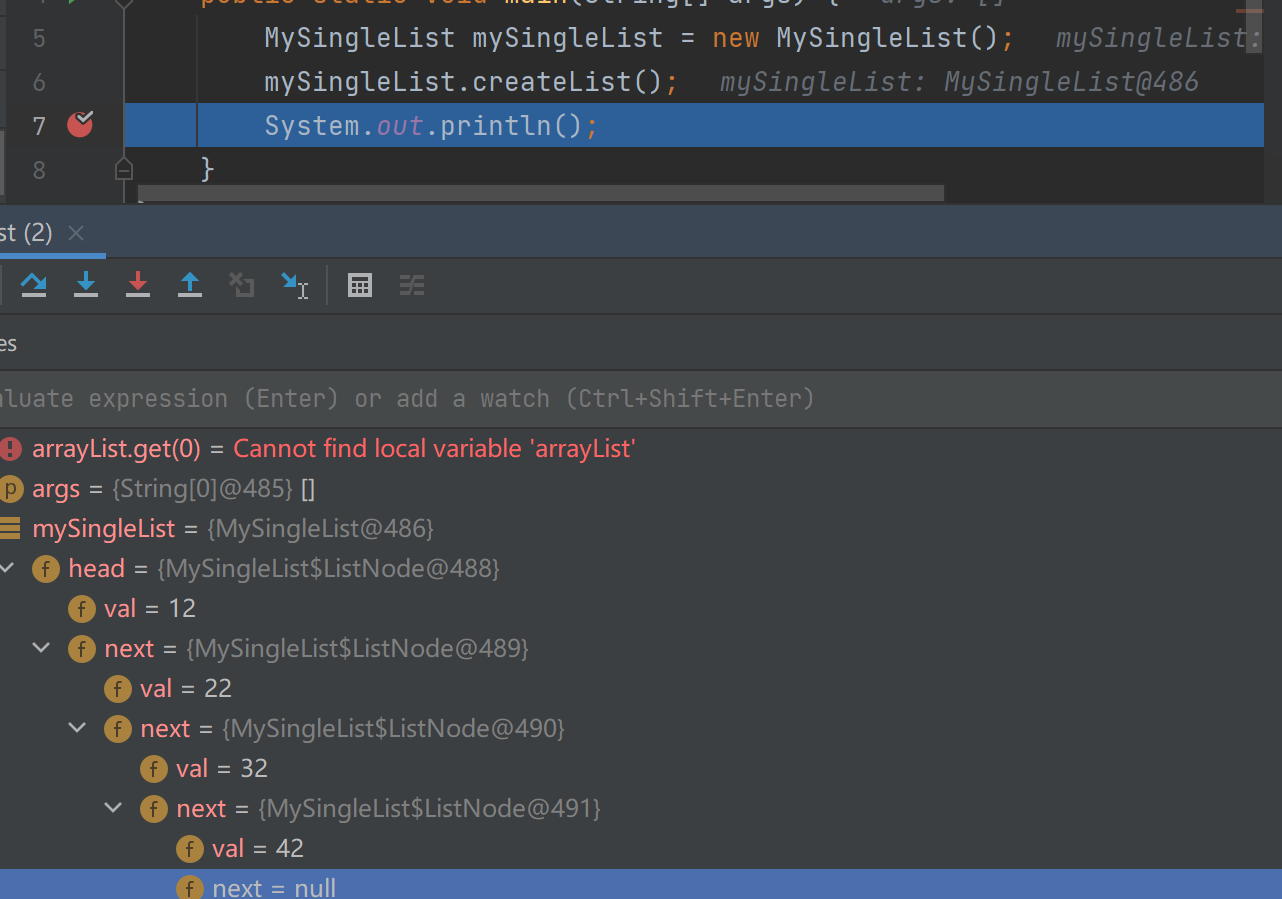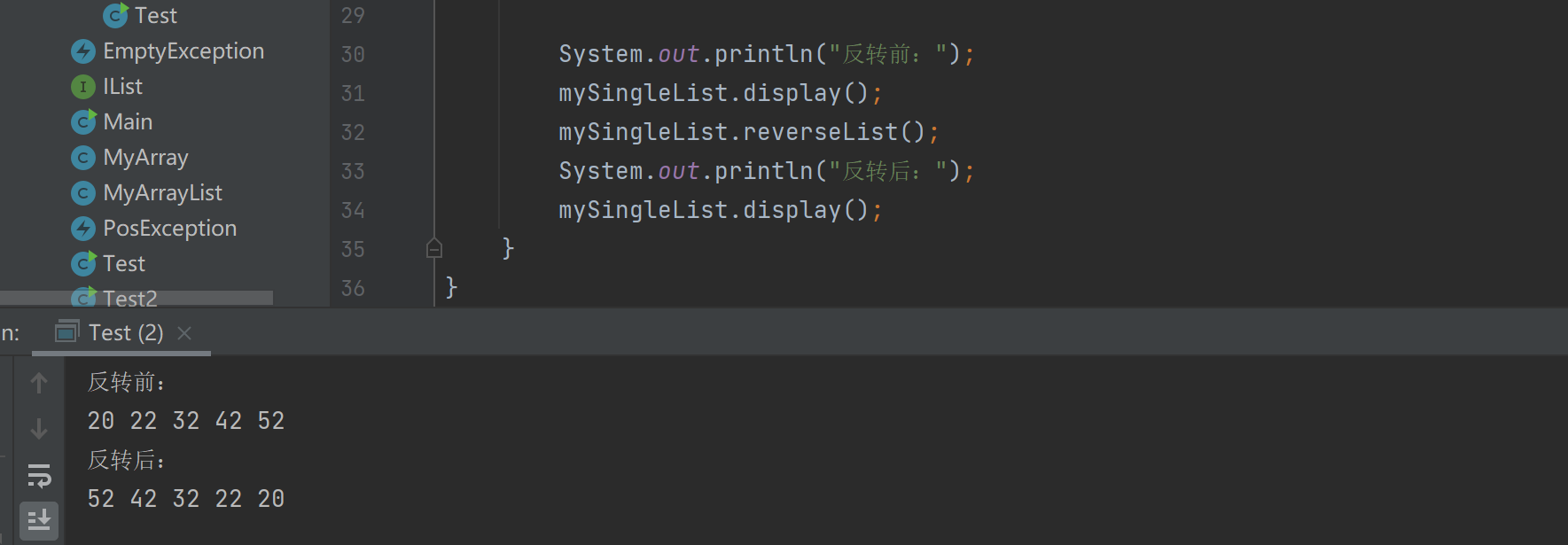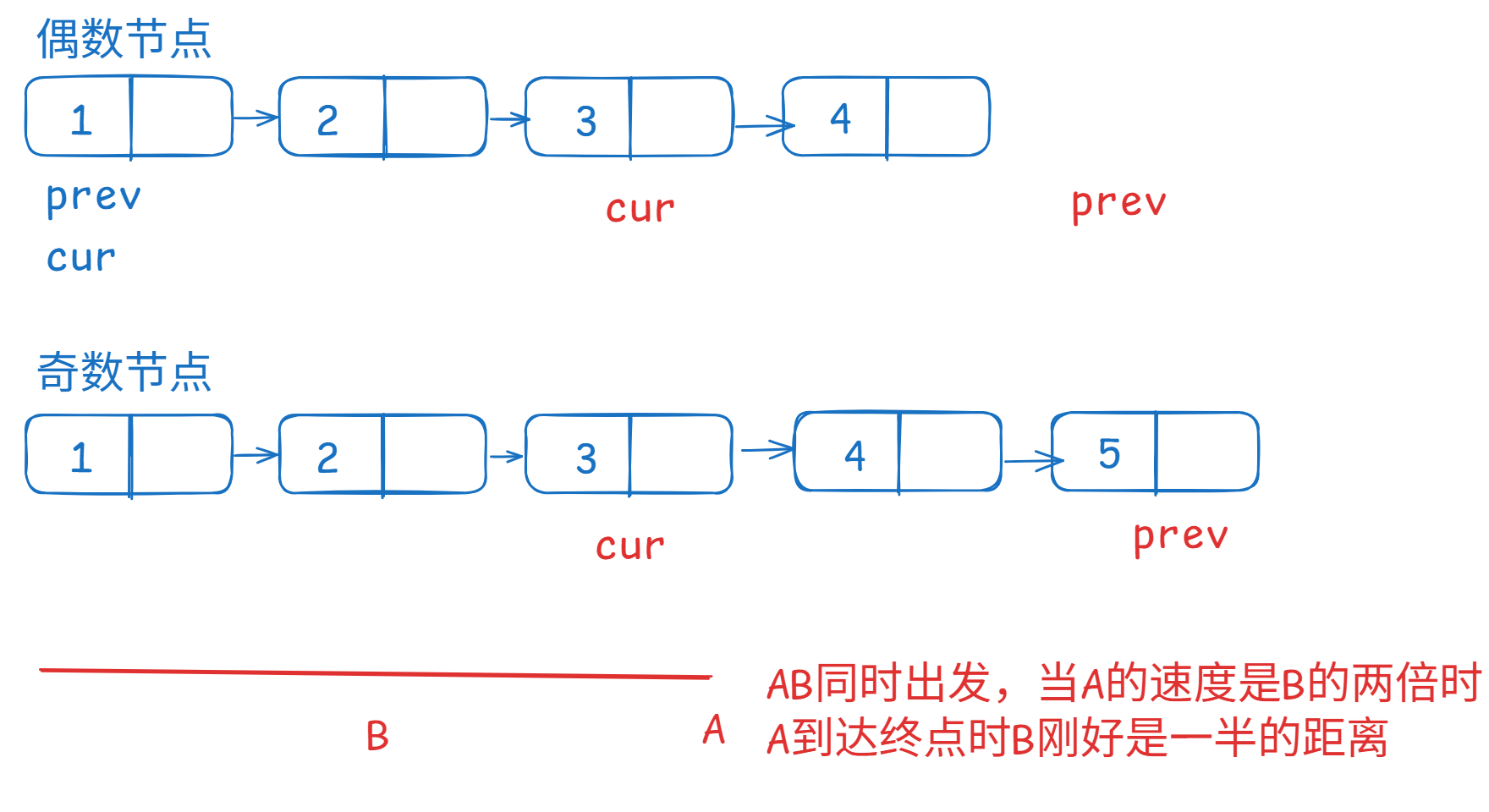目錄
鏈表的介紹
單鏈表的手動實現
單鏈表的基本框架
打印鏈表:
獲取表長:
頭插法新增節點:
尾插法新增節點:
在指定下標插入:
鏈表的查找
?刪除鏈表中第一個出現的key:
刪除鏈表中所有key值
鏈表置空
?總代碼
測試代碼
?鏈表相關的OJ題
1.反轉單鏈表
?思路:?
2.查找鏈表中間節點
?思路:1.判空;2.定義兩個指針,都指向head;3.設置循環,每次循環一個指針走兩步一個指針走一步,當走的快的那個指針到達最后一個節點時,慢的節點就在中間;
鏈表的介紹
基于順序表具有,插入數據,空間不足時要擴容,擴容有性能消耗和插入刪除數據時有時候需要大量的挪動數據,導致程序的執行效率低的缺點,延升出了鏈表。
鏈表,是一種邏輯結構連續物理結構不一定連續的一種數據結構;由一個個的節點組成,每個節點包含數據域和指針域,指針域指向下一個節點。
單鏈表的手動實現
單鏈表的基本框架
//不帶頭結點的單鏈表
public class MySingleList implements IList{//鏈表由若干個頭結點組成,每個節點都是一個完整的部分,所以可以定義一個內部類static class ListNode{public int val;//數據域public ListNode next;//指針域 存放下一個節點的地址public ListNode(int val) {this.val = val;}}public ListNode head;//定義一個存放節點的變量,默認值為null@Overridepublic void addFirst(int data) {}@Overridepublic void addLast(int data) {}@Overridepublic void addIndex(int index, int data) {}@Overridepublic boolean contains(int key) {return false;}@Overridepublic void remove(int key) {}@Overridepublic void removeAllKey(int key) {}@Overridepublic int size() {return 0;}@Overridepublic void clear() {}@Overridepublic void display() {}
}
為了更好的理解這個單鏈表的操作,我們先創建單鏈表的方法:
public ListNode head;//定義一個存放節點的變量,默認值為nullpublic void createList(){//1.通過實例化ListNode創建幾個節點ListNode node1 = new ListNode(12);ListNode node2 = new ListNode(22);ListNode node3 = new ListNode(32);ListNode node4 = new ListNode(42);//2.根據單鏈表的形態,把節點鏈接起來node1.next = node2;node2.next = node3;node3.next = node4;this.head = node1;}
打印鏈表:
public void display() {//1.借助一個cur節點去遍歷鏈表,移動cur的位置ListNode cur = head;while (cur !=null){//cur=null表示整個鏈表都走完了System.out.print(cur.val+" ");cur = cur.next;}System.out.println();}注意區分循環條件?cur !=null 和cur.next?!=null
獲取表長:
獲取表長的方法是打印方法衍生出來的,無非就是打印的方法中加一個計數器去記表長:
public int size() {ListNode cur = head;int count = 0;while (cur != null){//注意這個循環條件count++;cur = cur.next;}return count;}頭插法新增節點:
public void addFirst(int data) {//1.實例化一個節點ListNode node = new ListNode(data);//2.新增節點的指針域指向頭節點更新頭結點 順序不可變node.next = head;this.head = node;}?注意:
- 插入數據時先綁定后面,如果我們先綁定前面的話會發生什么呢?當this.head = node先執行的完后,新增節點指針域該指向誰了,為了防止數據丟失,插入數據時因先綁定后面
尾插法新增節點:
public void addLast(int data) {ListNode node = new ListNode(data);//1.找到鏈表最后一個節點if (head == null){head = node;}else {//遍歷鏈表去找ListNode cur = head;while (cur.next != null) {cur = cur.next;}cur.next = node ;//增}}在指定下標插入:
public void addIndex(int index, int data) {//1.判斷index的合法性if (index < 0 || index > size()){throw new IndexException("index非法"+index);}//表空的情況ListNode node = new ListNode(data);if (head == null){head = node;return;}//2.在0位置插入時調用頭插if (index == 0 ){addFirst(data);return;}//3.index=size()尾插法if (index == size()){addLast(data);return;}//在index位置插入時,找到index位置的前一個節點去操作ListNode cur = findPrevIndex(index);node.next = cur.next;cur.next = node;}private ListNode findPrevIndex(int index){ListNode cur = head;int count = 0;while (count != index - 1){count++;cur = cur.next;}return cur;}鏈表的查找
public boolean contains(int key) {ListNode cur = head;while (cur !=null){if (cur.val == key){return true;}cur = cur.next;}return false;}?刪除鏈表中第一個出現的key:
public void remove(int key) {//1.表空if (head == null){return;}//2.頭結點刪除if (head.val == key){head = head.next;return;}//3.中間元素刪除找key的前驅節點去操作ListNode cur = findPrevKey(key);cur.next = cur.next.next;//也可以借助一個變量去刪除/*ListNode del = cur.next;cur.next = del.next;*/}//盡量以方法的方式去實現功能,降低代碼的耦合度private ListNode findPrevKey(int key){ListNode cur = head;while (cur.next !=null){if (cur.next.val == key){return cur;}else {cur = cur.next;}}return null;}刪除鏈表中所有key值
public void removeAllKey(int key) {if (head == null) {return;}//定義兩個指針分別指向頭和頭的下一個ListNode prev = head;ListNode cur = head.next;//可能要被移除的元素while (cur != null) {//遍歷if (cur.val == key) {prev.next = cur.next;cur = cur.next;} else {//不用刪除就往后繼續遍歷prev = cur;cur = cur.next;}//此時除了頭結點其他節點都遍歷完了,就判斷頭節點if (head.val == key) {head = head.next;}}}鏈表置空
public void clear() {//法1:循環把每個節點都置空//法2:直接把最開始的節點中(只要是沒有人引用的對象內存都會回收置空),這樣就把整個鏈表置空了head = null;}
?總代碼
//不帶頭結點的單鏈表
public class MySingleList implements IList{//鏈表由若干個頭結點組成,每個節點都是一個完整的部分,所以可以定義一個內部類static class ListNode{public int val;//數據域public ListNode next;//指針域 存放下一個節點的地址public ListNode(int val) {this.val = val;}}public ListNode head;//定義一個存放節點的變量,默認值為nullpublic void createList(){//1.通過實例化ListNode創建幾個節點ListNode node1 = new ListNode(12);ListNode node2 = new ListNode(22);ListNode node3 = new ListNode(32);ListNode node4 = new ListNode(42);//2.根據單鏈表的形態,把節點鏈接起來node1.next = node2;node2.next = node3;node3.next = node4;this.head = node1;}@Overridepublic void addFirst(int data) {//1.實例化一個節點ListNode node = new ListNode(data);//2.新增節點的指針域指向頭節點更新頭結點node.next = head;this.head = node;}@Overridepublic void addLast(int data) {ListNode node = new ListNode(data);//1.找到鏈表最后一個節點if (head == null){head = node;}else {//遍歷鏈表去找ListNode cur = head;while (cur.next != null) {cur = cur.next;}cur.next = node ;//增}}@Overridepublic void addIndex(int index, int data) {//1.判斷index的合法性if (index < 0 || index > size()){throw new IndexException("index非法"+index);}//表空的情況ListNode node = new ListNode(data);if (head == null){head = node;return;}//2.在0位置插入時調用頭插if (index == 0 ){addFirst(data);return;}//3.index=size()尾插法if (index == size()){addLast(data);return;}//在index位置插入時,找到index位置的前一個節點去操作ListNode cur = findPrevIndex(index);node.next = cur.next;cur.next = node;}private ListNode findPrevIndex(int index){ListNode cur = head;int count = 0;while (count != index - 1){count++;cur = cur.next;}return cur;}@Overridepublic boolean contains(int key) {ListNode cur = head;while (cur !=null){if (cur.val == key){return true;}cur = cur.next;}return false;}@Overridepublic void remove(int key) {//1.表空if (head == null){return;}//2.頭結點刪除if (head.val == key){head = head.next;return;}//3.中間元素刪除找key的前驅節點去操作ListNode cur = findPrevKey(key);cur.next = cur.next.next;//也可以借助一個變量去刪除/*ListNode del = cur.next;cur.next = del.next;*/}//盡量以方法的方式去實現功能,降低代碼的耦合度private ListNode findPrevKey(int key){ListNode cur = head;while (cur.next !=null){if (cur.next.val == key){return cur;}else {cur = cur.next;}}return null;}@Overridepublic void removeAllKey(int key) {if (head == null) {return;}//定義兩個指針分別指向頭和頭的下一個ListNode prev = head;ListNode cur = head.next;//可能要被移除的元素while (cur != null) {//遍歷if (cur.val == key) {prev.next = cur.next;cur = cur.next;} else {//不用刪除就往后繼續遍歷prev = cur;cur = cur.next;}//此時除了頭結點其他節點都遍歷完了,就判斷頭節點if (head.val == key) {head = head.next;}}}@Overridepublic int size() {ListNode cur = head;int count = 0;while (cur != null){count++;cur = cur.next;}return count;}@Overridepublic void clear() {//法1:循環把每個節點都置空//法2:直接把最開始的節點中(只要是沒有人引用的對象內存都會回收置空),這樣就把整個鏈表置空了head = null;}@Overridepublic void display() {if (head == null){System.out.println("鏈表為空");return;}//1.借助一個cur節點去遍歷鏈表,移動cur的位置ListNode cur = head;while (cur !=null){//cur=null表示整個鏈表都走完了System.out.print(cur.val+" ");cur = cur.next;}System.out.println();}}
測試代碼
public class Test {public static void main(String[] args) {MySingleList mySingleList = new MySingleList();mySingleList.createList();System.out.println();mySingleList.display();//12 22 32 42System.out.println(mySingleList.size());//4mySingleList.addFirst(2);mySingleList.display();//2 12 22 32 42mySingleList.addLast(52);mySingleList.display();//2 12 22 32 42 52mySingleList.addIndex(2,20);mySingleList.display();//2 12 20 22 32 42 52System.out.println(mySingleList.contains(52));//truemySingleList.remove(12);mySingleList.display();//2 20 22 32 42 52mySingleList.addLast(2);mySingleList.addIndex(3,2);mySingleList.display();//2 20 22 2 32 42 52 2mySingleList.removeAllKey(2);mySingleList.display();//20 22 32 42 52mySingleList.clear();mySingleList.display();//鏈表為空}
}?鏈表相關的OJ題
1.反轉單鏈表
反轉一個單鏈表
?思路:
public ListNode reverseList(){if (head == null){return null;}if (head.next == null){return head;}//ListNode cur = head.next;//定義一個cur記錄當前需要反轉的節點head.next = null;while(cur != null){ListNode curNext = cur.next;//記錄下一個反轉點cur.next = head;//當前要反轉的節點指向headhead = cur;//更新headcur = curNext;//更新cur}return head;}2.查找鏈表中間節點
題目
?思路:1.判空;2.定義兩個指針,都指向head;3.設置循環,每次循環一個指針走兩步一個指針走一步,當走的快的那個指針到達最后一個節點時,慢的節點就在中間;
public ListNode middleNode(){if (head == null){return null;}ListNode fast = head;ListNode slow = head;while (fast != null && fast.next !=null){//順序不能反,否則報空指針異常fast = fast.next.next;slow = slow.next;}return slow;}?感謝大家閱讀📚點贊👍收藏?評論?關注?
博客主頁: 【長毛女士-CSDN博客】?



![[學習] Hilbert變換:從數學原理到物理意義的深度解析與仿真實驗(完整實驗代碼)](http://pic.xiahunao.cn/[學習] Hilbert變換:從數學原理到物理意義的深度解析與仿真實驗(完整實驗代碼))






——CRUD基礎)


)







